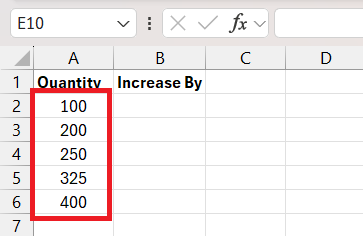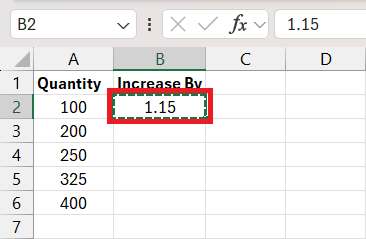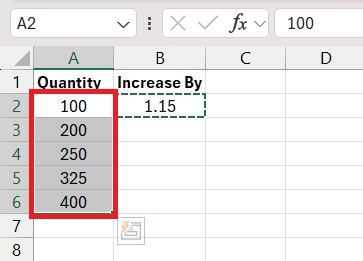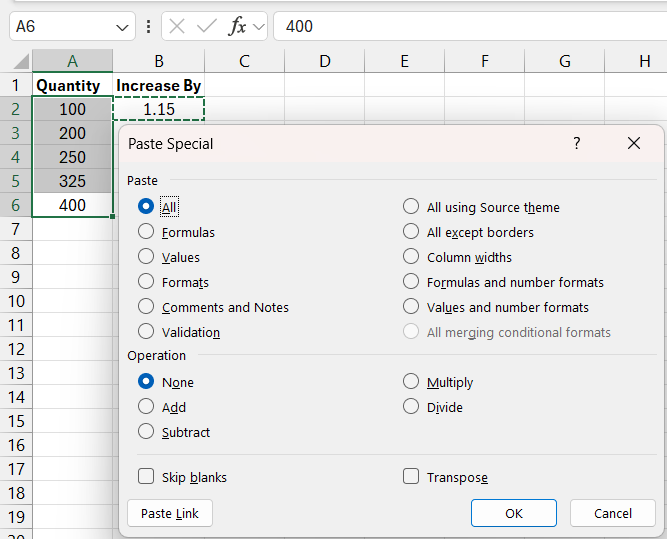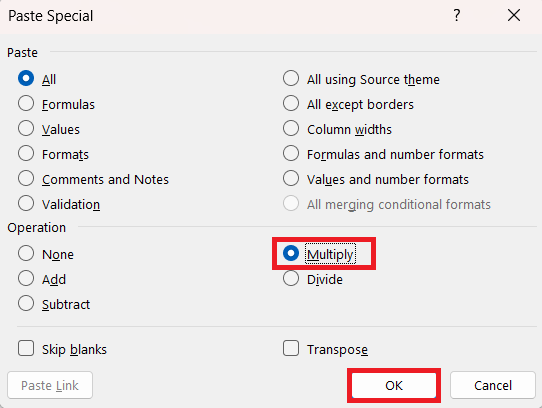

Key Takeaways
- To calculate the percentage share in Excel, set the destination cell’s format to percentages before entering any formula.
- Insert the formula for the percentage share calculation and use absolute cell references by adding “$” to prevent changes while copying.
- After entering the formula, press “Enter” to display the percentage in the selected format and drag the formula across other cells to populate them.
- For advanced Excel tasks, consider using PivotTables for data summarization, macros for task automation, and Power Query for data import and transformation.
- Always review and validate percentage calculations, document formulas used, and maintain clear formatting by including a decimal separator and percent symbol.
Download the workbook and follow along the tutorial on How to add 15 percentage in Excel – Download excel workbookAdd-15-percentage-in-Excel-Quick-Easy-Percentages-Formulas.xlsx
Unveiling Excel’s Percentage Capabilities
Introducing the Power of Excel Percentages
Excel has long stood as a bastion of efficiency for those grappling with numbers and data. Its cell-based structure, formula support, and rich suite of tools make it an unparalleled ally when it comes to manipulating numbers – including the art of handling percentages.
Understanding how to utilize Excel for percentage calculations opens doors to nuanced financial analysis, insightful data projections, and meticulous budgeting. Whether you’re in business, education, or using Excel for personal matters, harnessing its percentage capabilities lets you wield the power of precision and insight.
What Does Adding 15% Signify in Practical Terms?
Adding 15% to a figure is a practical necessity in various scenarios. It could signify a price hike on goods due to market inflation, the implementation of a strategic price increase to boost profit margins, or perhaps a periodic wage raise to account for employee cost of living adjustments.
In retail, a 15% markup could be the difference between cost price and retail price, enabling businesses to cover overheads and generate profit. For employees, a 15% salary increase can translate into a tangible reflection of recognition and reward for their hard work. In financial terms, adding 15% might represent an anticipated growth rate in revenue or investments over a set period.
In all these contexts, being able to adroitly add 15% to a base value in Excel means you can quickly calculate anticipated changes, plan accordingly, and communicate potential outcomes with stakeholders effectively.
Methodical Steps to Surge Prices by 15%
Method 1: Deploying Excel Formula for Instant Augmentation
Deploying the Excel formula for an instant 15% increase in a value is a matter of a few simple keystrokes. This method is straightforward and ensures instant results without the need for complex calculations.
Here’s how you can add a 15% increase to any number in Excel with an example: If A1 contains $100, input =A1*1.15 in B1 to yield $115 – the original price plus 15%.:
STEP 1: Select a Cell: Click on an empty cell where you want the adjusted value to appear.
STEP 2: Input Formula: Enter the following formula to calculate a 15% increase: =A*1.15
STEP 3: Observe the Result: Press Enter, and Excel will display the value after the 15% has been added.
This elegant and time-saving approach is a testament to why Excel is a tool of choice for professionals across disciplines.
Method 2: Harness Paste Special for Precision Edits
Excel’s Paste Special feature is a powerful ally for applying precise edits like a 15% increase across large datasets or to specific data points within your spreadsheet. This method helps to ensure accuracy and consistency with minimal effort on the user’s part.
To harness Paste Special to add 15% to your data, follow these steps:
STEP 1: Prepare Your Data: Make sure you have the original values that require the increase in one column (e.g., column A).
STEP 2: Calculate the Increase: Enter 1.15 (representing 15%) into any blank cell and copy it (Ctrl + C).
STEP 3: Select Data Range: Highlight the cells to which the 15% increase will be applied.
STEP 4: Open Paste Special: Right-click on the highlighted cells, choose “Paste Special,” and then select “Paste Special…” to open the dialog box.
STEP 5: Choose Operation: In the Paste Special dialog, under “Operation,” choose “Multiply” and click “OK.”
What happens here is magical – Excel multiplies each selected value by 1.15, effectively increasing each by 15%. This method prevents the need to create additional columns for intermediate calculations, thus maintaining a tidy workspace.
Additionally, Paste Special works not only for adding a specified percentage but also for other mathematical operations such as subtracting, dividing, or adding a flat figure to your selected range of cells. This adaptability makes Paste Special a versatile tool suitable for a variety of scenarios.
Nifty Tricks and Tips for Accurate Percentage Addition
Shortcut to Success: Swift Keyboard Commands
In the fast-paced digital workspace, proficiency with Excel’s keyboard shortcuts is a game-changer, enhancing both speed and productivity. One of the nifty shortcuts Excel offers is the quick transformation of numerical values into percentages using Ctrl + Shift + %.
Here’s a quick guide to Excel shortcuts related to percentage operations:
- Convert to Percentage: After selecting the cells containing the numerical values, pressing
Ctrl + Shift + %transforms those numbers into percentages, automatically multiplying them by 100 and appending the percentage sign. - Increase by Percentage: To add a 15% increase using a shortcut, add
1.15to an adjacent cell, copy it, select the data range, and then pressAlt + E, S, D, followed byEnterafter opening the Paste Special dialog. - Accurate Formatting: For formatting numbers as percentages without altering the underlying values, the key combination
Ctrl + 1pulls up the Format Cells dialog, where you can select the Percentage category.
Time-Saving Benefits: Using keyboard shortcuts in Excel, especially when dealing with larger datasets, saves a significant amount of time compared to navigating through menus with a mouse. Swift keypresses can accomplish tasks like applying formulas, formatting cells, and even recalculating entire worksheets.
Expand Your Skills: Further Adventures in Excel Percentages
Beyond Addition: Subtracting and Calculating Percentage Variance
In the world of data analysis, adding percentages is just one piece of the puzzle. At times, it’s equally important to understand how to subtract a percentage or calculate the variance between two values as a percentage, as these operations provide insights into trends, changes, and adjustments within your datasets.
Here’s how you can tackle these calculations in Excel:
- Subtracting a Percentage: To decrease a cell value by 15%, you’ll adjust the formula used for addition. Instead of multiplying by 1.15, you’ll multiply by 0.85 (1 – 0.15). The formula becomes
=A1*0.85. The original value is in A1. This reflects a reduction while maintaining the integrity of the scaled relationship.
- Calculating Percent Variance: Variance is a measure of dispersion between a pair of data points. To calculate it, subtract the original value from the new value, divide by the original value, and then multiply by 100. For example:
=((NewValue - OriginalValue) / OriginalValue) * 100. This gives you the percentage change between the two values.
In Excel, these operations offer more than just an understanding of numerical changes—they offer stories. Be it performance evaluations, comparative analyses, or budgetary reviews, calculating both increases and decreases in percentages provides you with narratives of growths or declines, efficiency improvements or setbacks, and other key indicators of performance.
Employing the correct Excel operations to perform these calculations can profoundly affect your ability to draw accurate conclusions and make informed decisions. By mastering these varied approaches to handling percentages, you enhance your analytical capabilities—turning raw data into meaningful insights.
FAQs About Mastering Percentages in Excel
What is the formula for 15% increase in Excel?
The formula to calculate a 15% increase on a value in Excel is very straightforward. You simply multiply the original number by the percentage increase expressed as a decimal (0.15 for 15%), and add the result to the original number.
Here’s the basic expression of the formula: =OriginalNumber * (1 + PercentageIncrease)
For a 15% increase, the formula becomes: =OriginalNumber * (1 + 0.15)
How Can I Ensure My Percent Increases are Correct?
To ensure your percent increases are correct in Excel, first, verify that the percentage increase is properly formatted as a decimal before applying it to the desired number. For example, to increase a number by 20%, multiply by 1.2. Additionally, always validate the results of your calculations by reviewing and cross-checking the formula used, and make sure to document your methodology to maintain clarity and consistency in your calculations.
What If I Want to Apply Different Percentage Increases to Various Items?
If you want to apply different percentage increases to various items in Excel, you would modify the formula for each item accordingly. For example, you would multiply each item’s original price by 1 plus its respective percentage increase, ensuring to convert the percentage into a decimal form (e.g., for a 15% increase, you would use 1.15). Remember to use parentheses to maintain the correct order of operations within your Excel formulas.
How to decrease a number by a percentage?
To decrease a number by a specific percentage in Excel, you will be using a similar approach to increasing a number, but instead of adding the percentage to 1, you will subtract it. This ensures that the original number is reduced by the given percentage amount.
Here is the general formula to decrease a number by a percentage: =OriginalNumber * (1 - PercentageDecrease)
To express this in terms of a specific example, decreasing a number by 15% would be represented as: =OriginalNumber * (1 - 0.15)
John Michaloudis is a former accountant and finance analyst at General Electric, a Microsoft MVP since 2020, an Amazon #1 bestselling author of 4 Microsoft Excel books and teacher of Microsoft Excel & Office over at his flagship MyExcelOnline Academy Online Course.




